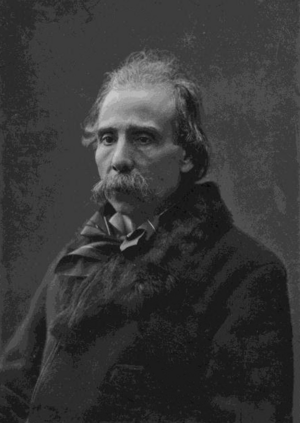Camilo Castelo Branco facts for kids
Quick facts for kids
Camilo Castelo Branco
|
|
|---|---|
 |
|
| Born | Camilo Ferreira Botelho Castelo Branco 16 March 1825 Lisbon, Kingdom of Portugal |
| Died | 1 June 1890 (aged 65) São Miguel de Seide, Vila Nova de Famalicão, Kingdom of Portugal |
| Occupation | novelist, playwright, essayist |
| Nationality | Portuguese |
| Genre | Romance novel |
| Literary movement | Romanticism |
Camilo Castelo Branco, also known as the 1st Viscount of Correia Botelho (born March 16, 1825 – died June 1, 1890), was a very active Portuguese writer in the 1800s. He wrote more than 260 books, including novels, plays, and essays.
His writing style was unique. It mixed the emotional and dramatic feelings of Romanticism with his own special blend of sarcasm, sadness, and dark humour. People also remember him for his cleverness and interesting stories. He had a very eventful and sometimes sad life.
Camilo's stories often focused on local places and traditions. His style is sometimes compared to another famous Portuguese writer, Eça de Queiroz. Eça was 20 years younger and preferred a more modern, realistic style, while Camilo stayed closer to the Romantic tradition. This difference shows the two main writing styles in Portugal during the 19th century.
Camilo was known for his traditional and Catholic beliefs. He often showed these ideas in his literature.
Biography
Camilo was born in Lisbon and became an orphan when he was very young. Even though his family had noble roots in Northern Portugal, his father lived in poverty. Camilo spent his early years in a village called Trás-os-Montes. There, he was taught at home by his three aunts.
When he was 13, he went to a Catholic school in Vila Real, where priests educated him. He was very interested in literature and was good at Greek and Latin. However, Camilo was often distracted and proud.
From age 17 to his early twenties, he studied medicine and theology in Oporto and Coimbra. Eventually, he decided to become a writer. He worked as a journalist in Oporto and Lisbon. Later, he went to a seminary in Oporto to study for the priesthood. During this time, Camilo wrote religious works and translated books by other authors.
Camilo took some steps towards becoming a priest, but his restless nature led him away. He decided to focus on writing for the rest of his life. He faced some difficult times, including periods when he was held in prison. During one of his longer times in prison, he wrote what many consider his best work, Amor de Perdição. This experience also inspired his book Memórias do Cárcere (which means "Memories of Prison"). In this book, he described the prison in Oporto and shared his personal thoughts.
In 1885, Camilo was given the title of viscount (Visconde de Correia Botelho) to honor his great contributions to literature. When his health got worse and he could no longer write, the government gave him a lifelong pension.
Works
Camilo Castelo Branco is one of the most productive Portuguese writers ever. His work includes novels, plays, poems, and essays. He was also the first Portuguese writer who could earn enough money just from his writing. He published around 560 works, but he is most famous for his novels.
Even though Camilo wrote a lot to make a living, he always kept his unique style. He knew many different kinds of people, which helped him create memorable characters in his stories. These characters included the "brasileiro" (a Portuguese person who made a fortune in Brazil) and the old "Fidalgo" (nobleman) from northern Portugal.
Camilo's novels can be grouped into three main periods:
- His first period includes imaginative stories, like Os Mistérios de Lisboa.
- The second period features his novels of manners. These books showed the daily and social life in Portugal in the early 1800s very well.
- The third period covers his writings on history, biographies, and literary reviews. Examples include Noites de Lamego and Memórias do Bispo do Grão Pará.
Some of his most famous novels are O Romance de um Homem Rico, Retrato de Ricardina, Amor de Perdição, and A Brasileira de Prazins. Many of his novels, like Onde está a felicidade?, Memórias do Cárcere, and Vingança, are about his own life.
Camilo was an amazing storyteller. He had a very rich vocabulary, using many words that are not common. At the same time, he also knew the everyday language of the people very well. While he had a poetic spirit, his poems are not considered his best work. However, his plays are strong and dramatic, and his comedies are funny in a sharp, clever way.
Film and television adaptations
- Amor de Perdição (TV series) (1965)
- Amor de Perdição (1979) by Manoel de Oliveira
- Um Amor de Perdição (2009) by Mario Barroso
- Mistérios de Lisboa (2010) by Raúl Ruiz
- O caderno negro (2018) by Valeria Sarmiento
See also
 In Spanish: Camilo Castelo Branco para niños
In Spanish: Camilo Castelo Branco para niños

